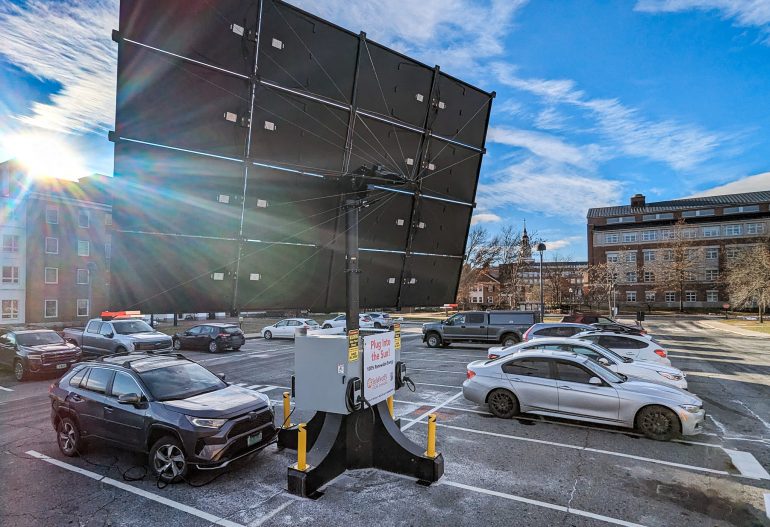Dartmouth College has installed the area’s first off-grid solar electric vehicle charging station that’s designed for workplaces facing a fast-growing number of EV commuters. As part of this pilot project, four lucky Dartmouth employees who drive EVs or plug-in hybrids will be chosen by lottery to be the first to hook up to this pioneering charging solution in the Maynard parking lot.
At this Hanover, New Hampshire charging site, there’s enough annual sunshine to provide each of the four participating employees with up to 10,000 miles of EV charging a year. That’s more than double the annual commute for the average Dartmouth employee. The Solar EV Charger has a cost per mile that’s only about one-quarter of what most commuters spend on gasoline each year, making it cheaper than just about any other fueling option on the market. And perhaps best of all, the ‘fuel’ to get these Dartmouth employees to and from work will be 100% renewable, coming straight from the sun.

Clean EV Charging with Proven Solar Design
Solaflect Energy, based in Norwich, Vermont, is the designer and manufacturer of this groundbreaking EV charging system. The Solar EV Charger is energized by a time-tested, dual-axis Solaflect tracking array, with more than 1,200 installations and 40 million hours of operating experience across New Hampshire, Vermont and western Massachusetts. A Solaflect Tracker has been operating on the Dartmouth College campus behind Baker-Berry Library since 2016.
The new Solar EV Charger includes a 6.2 kilowatt solar array that disburses energy through four Level 2 charging ports for workplace parking locations. Solaflect’s first installations will be in New England, followed by a nationwide expansion.

A Local Solution for a National Charging Need
In the U.S., passenger vehicles are the largest source of emissions tied to global warming. Ten states, including Vermont and Massachusetts, plan to ban sales of new gasoline-powered cars by 2035. This will require the buildout of a nationwide charging network for 30 million EVs expected to enter service by 2030.
For each new EV placed on the road, almost one additional EV charging port will need to be installed, according to the U.S. Department of Energy. That means 26.8 million Level 1 and Level 2 charging ports will need to be placed in private locations, like homes and workplaces, by 2030, plus another 1 million Level 2 charging ports in public locations, like workplace settings, park & rides, and retail outlets. Another 182,000 fast-charging ports will need to be strung along the nation’s highways by 2030 to support EV driving over longer distances.
Unfortunately, this buildout of public EV charging stations is falling behind schedule and faces big obstacles. For example, many potential EV charging locations lack access to transmission lines that can support Level 2 or fast chargers, requiring costly utility upgrades. In addition, digging and installing underground electrical conduit requires parking lot construction permits and hiring electrical contractors that can delay installations by months or even years.
By comparison, installation of the Solaflect Solar EV Charger takes only a day, without any time-consuming construction permits or grid interconnections. In an increasingly EV-powered world, this off-grid design creates an ideal EV charging solution that alleviates “range anxiety” among EV commuters and pays for itself.

Here’s a quick snapshot of the Solar EV Charger:
- Powered by a 6.2 kilowatt solar array, mounted on a dual-axis tracker that generates 40% more power than comparable fixed panel arrays. 6-ton concrete foundation sits right on parking lot lines, so doesn’t take up any parking spaces, and provides enough ground clearance for unimpeded traffic flow.
- Climate-resilient design sheds snow quickly, stows flat in high winds, and sits high enough to avoid flooding. On-site solar power means it can operate when the grid is down. Transportable to new sites as EV charging needs grow and evolve.
- Much faster and less expensive to install than grid-connected EV charging stations.
- Avoids costly utility demand charges that can ruin the economics of some unmanaged EV charging sites. No need to spend on costly “EV-ready” infrastructure in anticipation of future parking lot upgrades – Solar EV Chargers scale up easily, one for every 4 EVs/plug-in hybrids.
- Locks in one million miles of EV charging with minimal operating and maintenance costs over the expected 25 year life.
- Available for annual lease with no additional service cost, or for purchase with benefit of 30% federal investment tax credit. Numerous grant funding options available that can reduce cash outlays by up to 80 percent.
Solaflect Energy is your home energy management and clean commuting partner. We offer sun-tracking solar arrays for home use and affordable off-grid Solar EV Chargers for commuters and workplace use. Check out our residential solar website; for more information, or email us or call (802) 649-3700. Working together, we can make a difference in the fight against global climate change – and reduce the cost of energy right in our hometowns.




